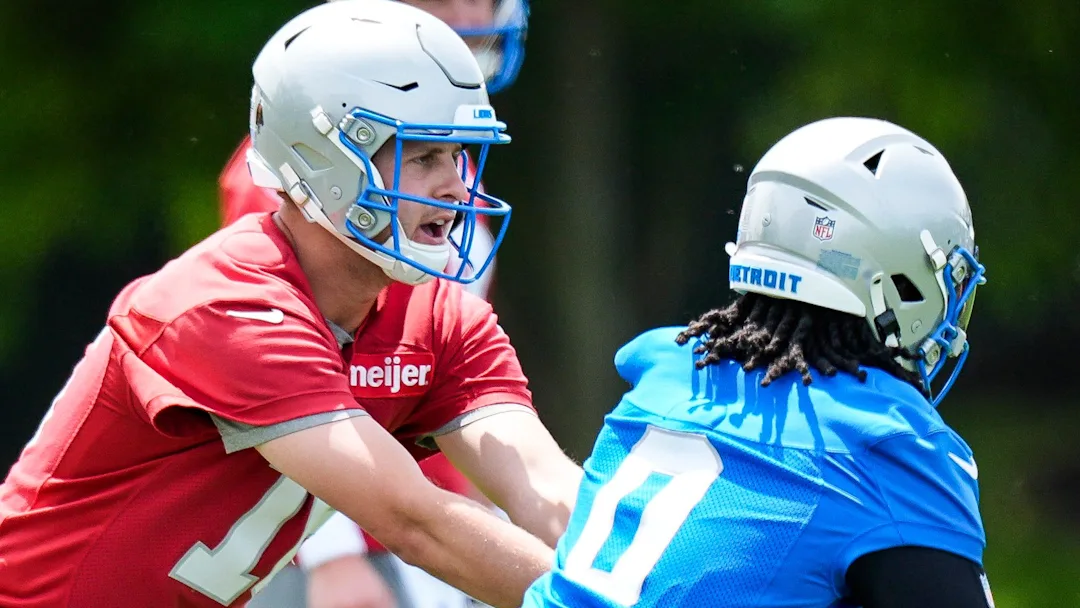**Detroit Lions Plan to Deploy Star Running Back in New Ways**
The Detroit Lions are entering the 2024 season with heightened expectations, coming off a thrilling playoff run that reignited the passion of their long-suffering fanbase. A key factor in their resurgence has been the emergence of their star running back, Jahmyr Gibbs, whose electrifying playmaking ability has added a new dimension to their offense. However, head coach Dan Campbell and offensive coordinator Ben Johnson are not content to rely on the same old schemes. Instead, they are preparing to deploy Gibbs in innovative ways, maximizing his versatility to keep defenses guessing and further elevate an already explosive offense.
Gibbs, the 12th overall pick in the 2023 NFL Draft, quickly proved he was worth the investment. His blend of speed, agility, and receiving prowess made him an instant weapon, whether as a traditional ball-carrier or a mismatch in the passing game. Yet, despite his impressive rookie campaign, the Lions’ coaching staff believes they’ve only scratched the surface of his potential. This season, fans should expect to see Gibbs utilized in more creative alignments, including expanded roles in the slot, as a motion weapon, and even in two-back sets alongside power rusher David Montgomery.
One of the most intriguing aspects of Detroit’s evolving offensive strategy is their commitment to leveraging Gibbs’ receiving skills. While he was already a frequent target out of the backfield last season, Johnson has hinted at using him more as a true wide receiver in certain packages. Gibbs’ route-running ability and quickness make him a nightmare for linebackers in coverage, and against nickel corners or safeties, his acceleration after the catch could lead to explosive plays. Expect the Lions to motion him out wide frequently, forcing defenses to either shift personnel or risk leaving him in favorable one-on-one matchups.
Another area where Gibbs’ role is expected to expand is in pre-snap motion. The Lions have increasingly embraced motion under Johnson’s guidance, using it to create defensive confusion and exploit mismatches. Gibbs’ speed makes him an ideal candidate for jet sweeps, orbit motions, and fake reverses—all of which can freeze linebackers and open up running lanes for Montgomery or quarterback Jared Goff on play-action bootlegs. By using Gibbs as a decoy just as often as a primary option, Detroit can keep opponents from keying in on him while still capitalizing on his game-breaking ability when the opportunity arises.
Perhaps the most exciting development is the potential for Gibbs and Montgomery to share the field more often. Last season, the two backs were often used in a clear rotation, with Montgomery handling early-down and short-yardage work while Gibbs served as the change-of-pace dynamo. However, the Lions have experimented with two-back formations in camp, suggesting they may deploy both simultaneously to create defensive conflicts. Picture Gibbs split out as a receiver with Montgomery in the backfield—does the defense stay in base personnel and risk Gibbs burning a linebacker, or do they sub in an extra defensive back and become vulnerable to Montgomery pounding the rock? These are the kinds of dilemmas Detroit wants to force, and Gibbs’ versatility is the key to unlocking them.
Additionally, the Lions are likely to explore Gibbs’ potential in the screen game. While screens have always been a part of his skill set, Detroit’s offensive line—one of the best in football—excels at setting up these plays. With guards like Jonah Jackson and Kevin Zeitler pulling into space, Gibbs could turn short passes into long gains with his elite open-field agility. The threat of the screen also helps slow down pass rushes, giving Goff more time to attack downfield when defenses start cheating up to stop Gibbs.
Of course, none of these innovations would be possible without Gibbs’ football IQ. Despite his relative youth, he has shown an advanced understanding of defensive schemes and an ability to adapt on the fly. Campbell has praised his work ethic and willingness to embrace multiple roles, which has given the coaching staff the confidence to expand his responsibilities. Gibbs isn’t just a runner or a receiver—he’s a hybrid weapon who can line up anywhere, and Detroit plans to take full advantage of that.
Defenses around the league will undoubtedly be studying ways to contain Gibbs, but the beauty of the Lions’ approach is that it doesn’t rely solely on him. With Amon-Ra St. Brown commanding attention in the slot, Jameson Williams stretching the field vertically, and Sam LaPorta emerging as a top-tier tight end, opponents can’t afford to focus entirely on stopping the run. This balanced attack is what makes Detroit’s offense so dangerous, and Gibbs’ evolving role only adds another layer of unpredictability.
As the season approaches, all eyes will be on how these new wrinkles unfold. Will Gibbs see an increased target share in the passing game? Will he take direct snaps in wildcat formations? Could he even become a factor in the return game in certain situations? The possibilities are endless, and the Lions’ willingness to think outside the box could be the difference between a good offense and a truly elite one.
For Gibbs, the opportunity to showcase his full skill set is both a challenge and an honor. He has already proven he belongs among the NFL’s most dynamic playmakers, but his second season could be the one where he cements himself as a superstar. And for the Lions, unlocking his potential in new ways might just be the key to taking the next step—from playoff contender to Super Bowl threat.
In a league where innovation separates the good teams from the great ones, Detroit’s plan to deploy Jahmyr Gibbs in fresh, unpredictable ways could be the X-factor that propels them to new heights. Fans should buckle up—because the Lions’ offense is about to get even more exciting.



